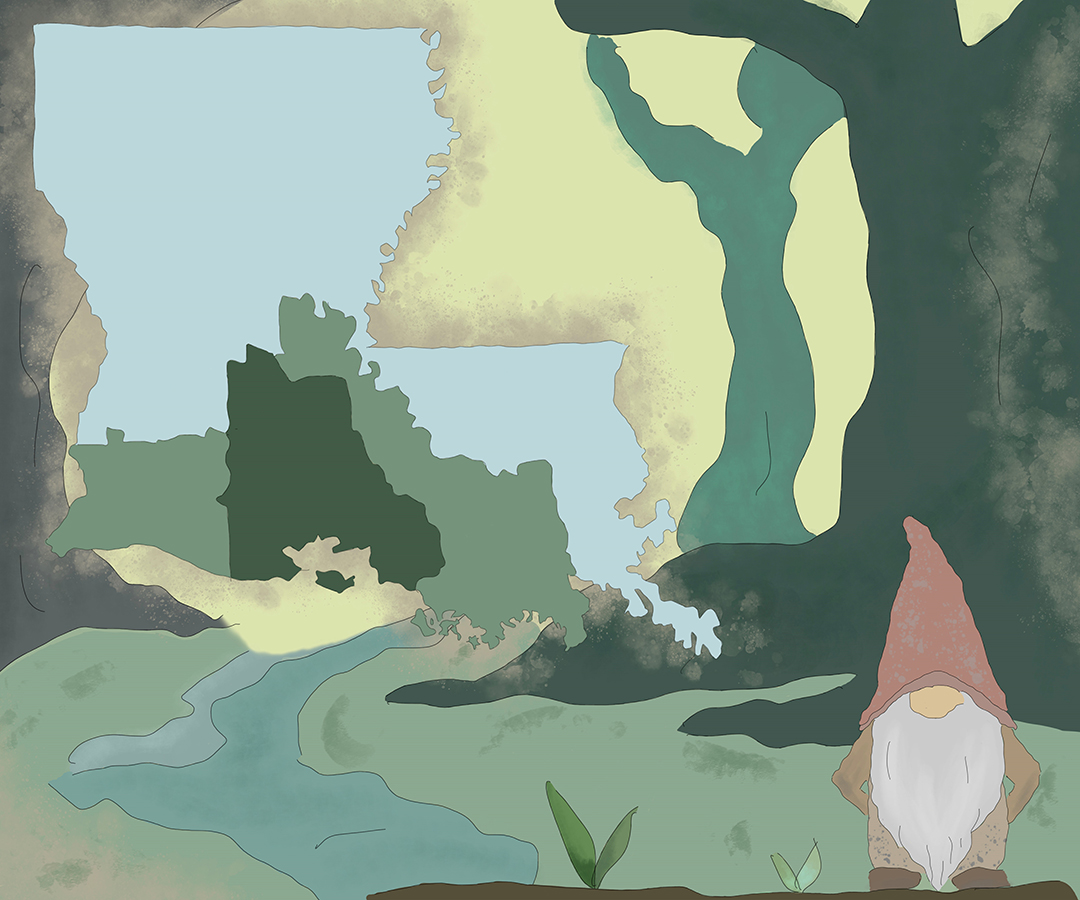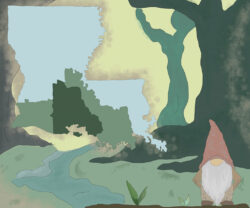Cajun Folktales
Cajun Folktales are heavily influenced by French, West African, Caribbean, Acadian, German, and American South oral traditions.

Courtesy of the Louisiana Endowment for the Humanities
An Illustration of a lutin by Cecilia Tisserand, 2022.
Cajun folktales are part of the oral tradition of Louisiana’s Cajuns, who predominantly reside in the region widely known today as Acadiana. The Cajun folklore repertoire is heavily influenced by the French oral tradition, but various characters, tale types, and motifs reflect a variety of other cultures, including West African, Caribbean, Acadian, German, and the wider American South. Because of the multiplicity of definitions and cultural overlap between Cajun and Creole communities, there is also to some extent a shared repertoire depending on one’s definition of each group. Below is an overview of a few of the categories of folktales and folklore figures in the Cajun oral tradition.
Magic Tales and Fairy Tales
Most early folklore studies in Louisiana focused on European vestiges of the fairy tale tradition. Familiar tales bearing much resemblance to their European counterparts do not appear to be particularly numerous in the overall repertoire of archived and transcribed folktales. However, notable examples like Cendrillon (Cinderella), Le petit Poucet (Little Thumbling), and Snow Bella (Snow White) have been collected by folklorists such as Elizabeth Brandon, Corinne Saucier, Calvin Claudel, and Barry Jean Ancelet.
Tricksters and Fools
The trickster is arguably the most prevalent character type in the Cajun oral tradition and is invariably portrayed as the hero of the story. Perhaps the most well-known trickster is Lapin (“rabbit” in French). Lapin is often accompanied by the foolish Bouki, whose name is derived from the Wolof word for “hyena.” This trickster/dupe dynamic lends itself to many common tale types found elsewhere in oral tradition such as In the Division of the Crop the Fox Takes the Corn and The Tarbaby and the Rabbit, analogous to the well-known Br’er Rabbit stories popularized by Joel Chandler Harris.
Another prevalent trickster figure is the Fin Voleur (the master thief). While this figure is found throughout Europe and elsewhere, in French-speaking Louisiana the master thief is often named Roquelaure (or some variation of that name), whose origins can be traced back to the noble Roquelaure family of Gascony, France. Like Robin Hood, Roquelaure’s story often begins at his childhood when he must leave his impoverished family to learn a trade. After mastering the art of thievery, he returns home to defy and outwit a greedy king through a series of challenges.
If the trickster figure demonstrates Cajuns’ affinity for wily characters who can adapt and succeed through their wits, Jean Sotte serves as a kind of counterexample of one’s fate when one fails to understand the world around him. Jean Sotte (a variation of Jean-le-Sot or “Foolish John”) could be considered the quintessential fool of Cajun folklore. Jean Sotte is often the victim of his own inability to comprehend the needs and happenings of daily life. In many cases he displays a lack of understanding by taking his mother’s orders literally. These tales often function on puns or homonyms. In one tale, when his friend instructs Jean Sotte to “throw eyes” on a girl to flirt with her, Jean pluck the eyes of a sheep and throws them at her. While nevertheless meant to be humorous, it is always clear that Jean Sotte’s errors cause his family grief or loss of valuable goods. From two opposing angles, Jean Sotte and the trickster figure both convey the importance of wit, adaptability, and understanding the complexities of life to survive.
Figures of Fortune and Omen
Cajun folklore abounds with figures who, although not part of a fixed folktale type or narrative, are symbolic of potential punishment or doom for one’s misgivings. These are often recorded or transcribed, not as narratives or folktales per se, but rather as personal accounts.
One of the most iconic elements of Cajun folklore is the feu follet (will-o’-the-wisp, literally “fool’s fire”). The actual result of gases emitted from decomposing plant matter in marshy areas, the feu follet has given rise to a multitude of folk beliefs aiming to explain the ethereal sight. In Louisiana, as is the case in France, it was widely believed that feux follets represented the souls of unbaptized children. This belief was predicated on Catholic dogma, which purported that unbaptized children, although innocent, were nevertheless stained with original sin, precluded from entering heaven, and relegated to an eternal state of limbo on Earth.
In southeastern Louisiana the rougarou (from the French loup-garou or “werewolf”) and the lutin (“elf” in French) are particularly prevalent. Despite the origin of the rougarou’s name, the creature is practically never described as a wolf, which is likely evidence of adaptation to the context of Louisiana, where wolves are exceedingly rare. It should be noted the rougarou is not entirely a malevolent figure but, rather, a cursed being seeking release by transferring its curse to another. In many instances of rougarou accounts, the witness refers to a human who is either a shapeshifter by nature or who is temporarily cursed, likely as a punishment for wrongdoings, and seeks to transfer their affliction to an unsuspecting victim. The lutin is a more human-like, impish figure known for braiding the manes of horses and riding them during the night, stealing from barns or houses, and other mischief. Attestations of both the lutin and rougarou are relatively localized to the southeast region, which is likely evidence of a reinforcement of similar figures found in local Native American cultures, such the bohpoli of the Choctaw tradition.
Madame Grands Doigts (“Lady Long Fingers”) is a peculiar folklore figure in that she has different representations depending on the precise region and even in specific family circles. While in some contexts she is described as a kind of witch who seeks to harm children who, for example, are caught staying out after dark or have behaved poorly, other interpretations depict her as a benevolent being. In some cases Madame Grands Doigts is related to the Christmas holiday season and can bring small gifts, fruits, or nuts to children on New Year’s Eve. A similar figure known as La Christine (derived from the German Christkind or “Christ child”) can be found in and around Saint Landry Parish.
